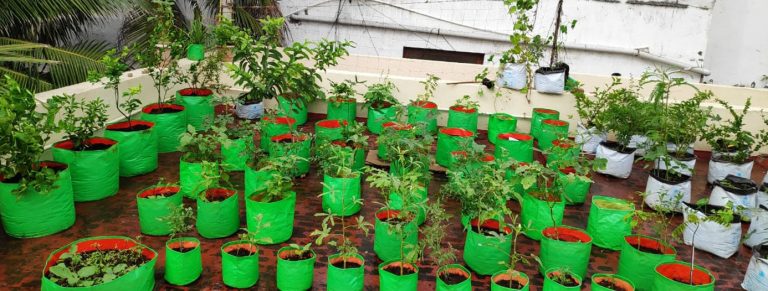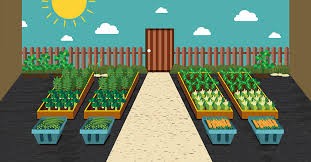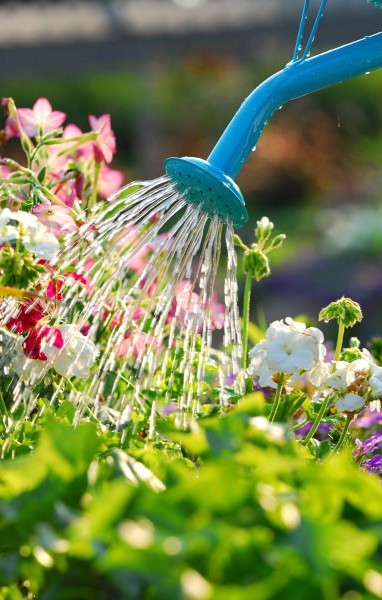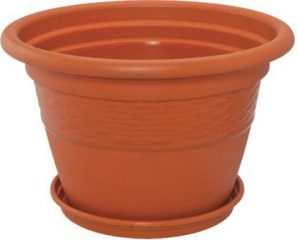
E. Manure
Manure should be added to the plants grown in pots at least once a month. This can be manure made by earthworms, cowdung, jivamrut (natural liquid fertiliser prepared by mixing water, urine of cows jaggery and flour to speed growth of microbes) or homemade compost (made from vegetable stalks, fruit skins, peels of onion and garlic etc.). Once a week the plants can be sprayed with 10 to 20 ml gomutra (Urine of cow) diluted in water. If you rear cattle than you can prepare a naural organic manure by mixing cowdung, urine of cow, jaggery or flour of bipartite pulses such as tur (Pigeon pea), chickpea, green gram and chawli (Cow pea). This helps in growth of the plant and improves the soil quality. This manure is of best quality and can be easily prepared at home.
1. Preparation of Jivamrut
Jivamrut is prepared from gomutra (Cow urine), cow dung, jaggery and flour of pulses. Approximately 200 litres of water is taken and 10 litres of gomutra, 10 kilograms of cow dung, 1 kilogram yellow or black jaggery and 1 kilogram of flour of pulses (tur, gram, green gram, cow pea etc.) are mixed in it. This mixture is stored for 8 days and stirred gently with a stick, twice a day. Small quantities of this manure can be prepared by maintaining the proportion. Within 8 days this manure produces abundant microbes conducive for growth of the plants. This manure provides plants with the essential nutrients.
If a plant is infected by insects or disease then it should be sprayed with neem or tobacco, garlic and chilli juice as these are insecticidal. Instead of using the same juice everytime, one can use different juices in rotation.
F. Compost pot (without soil)
For growing vegetables in a pot, adequate amount of moisture, air ventilation, appropriate quantity of water drainage and easy growth of roots is required. When saplings are sown in the farm, the excess water given to the plants seeps deep into the soil, but in terrace gardening no matter how many openings the pot has, the soil in the pot still retains the water. As a result, air circulation is obstructed affecting the growth of the sapling. To avoid this, in terrace gardening as far as possible minimum soil is used. Instead, wet and dry garbage is used. In the past few years, the concept of soil-less (or using minimum soil) terrace gardening is becoming more and more popular.
1. Essential ingredients for preparing a pot for soil-less farming
Dry waste (coconut husk well crushed with the hands, rice husk, sugarcane waste, dried leaves, sand, small pieces of bricks), wet waste (good compost/worm manure, neem oilcakes, bio-culture, kitchen waste) and culture (catalyst for the process of preparing manure similar to the butter milk which is added to milk to make curd)

2. Method of filling the pot for planting
To prepare compost use 30% wet waste and 70% dry waste in that proportion. Wet waste can include stalks of vegetables, dried leaves, fruit skin, seeds, used tea powder, infected food grains, stale food and rotten part of fruits. Please do not use oily or spicy stale food in this. If you want to use such food, then wash it with water in a sieve to remove the oil, salt and spices from it and strain. Mulch of trees, dried leaves and twigs are included in dry waste. Spread the dried leaves and mulch or well teased coconut husk at the bottom of the pot. Add some culture to it. These include the baseline microbes required for the composting process. Dung of a Bharatiya cow is an excellent form of culture. Culture should be mixed with water before using. Although there are different kinds of commercially available cultures, dung of the Bharatiya cow or sour buttermilk, curd and jaggery water are natural form of cultures. After adding culture to the dry waste, wet waste should be added on top of it. Wet waste should be grinded before adding. This enhances the process of decaying. Add a layer of dry waste and culture alternately till the pot is filled upto 2 inches below the rim of the pot. Finally cover the pot with a cotton cloth. After every 3rd day the waste should be mixed well. Once or twice a week add culture to it and to prevent occurrence of worms add neem leaves. If neem leaves are unavailable, then use neem oilcakes. If worms develop in the compost, then add some dried leaves or mulch. If you want to use soil, then add it as the second layer above the layer of coconut husk. Do not use soil in the further layers. When composting from waste, keep in mind that waste should be decomposed and not rottened. (Decomposition is a natural process while rottening is unnatural. Decomposition is brought about by benevolent microbes and rottening by malevolent microbes. Decomposition occurs only if oxygen is available and rottening occurs in the absence of oxygen. Decomposition does not emit a strong dirty odour while rottening does). In this process, you may use the ‘waste decomposer’ from the National Centre for Organic Farming to enhance the process of decomposition. If composting emits dirty odour, mix half a teaspoon of turmeric or asafoetida in water and pour over it.
In this way you can get good quality compost in 2 to 3 months. Dry the compost in the sun for 2 to 3 hours. When compost is ready it smells like wet soil. It can be used for planting saplings or sowing seeds or as a manure. When such compost is used there is no need for fertilizer. When wet waste is put in pots like this it does not emit any odour. Also, it prevents pollution due to garbage and protects the environment. Besides as wet waste in a pot retains water, watering can be done less frequently.
G. Growing saplings from seeds
Once a pot is ready either a sapling can be planted or seeds can be sown. If the seeds are tiny then sprinkle two pinches of seeds equidistantly and cover them with a layer of soil, triple the size of the layer of seeds. Then take water in a mug and sprinkle water over the soil with your hands. You can also sow seeds in a tray. Once 5 to 6 leaves appear, transfer the saplings into the pot. When doing this ensure that the plant remains in the shade. Avoid direct sunlight as it can dry the roots and kill the plant. When transferring the sapling into the pot uproot it with the soil. Some plants e.g. rose, hibiscus or spices cannot be grown as saplings, their branches when cut in a particular manner and planted in the soil give rise to new plants.
1. Importance of organic seeds
Today though several kinds of seeds are available in the market the organic ones are the best. Though seeds produced through genetic engineering technology may give a better yield they are not nature friendly. In fact, promotion of hybrid seeds is a conspiracy to ruin traditional Bharatiya farming. Organic seeds possess the inherent natural genes to sustain in the local environment. They are more fertile and nutritious and can be procured from a local farmer. If the seeds are pure then the saplings that grow from it are healthy and fresh.
H. Sunlight

When growing vegetables some amount of heat is required. Plants grow well in sunlight. Even if this is true, it does not mean that plants do not grow at all if they do not get sufficient sunlight. Especially in cities if plants are grown on the terrace or on window sills, availability of sufficient sunlight could be an issue. In such conditions, one can grow vegetables, however, they are not as nutritious as those grown in adequate sunlight. As per nature’s rule size of the leaves of plants, grown without sunlight, become larger. Colocasia, pepper, betel, Crossandra infundibuliformis are the plants which can grow even in less sunlight.
I. Water

Excess water can kill a sapling. Most people have the habit of giving a lot of water to the plants grown in the pot; but this is not necessary. One can sprinkle palm full of water on the plants. On the next day if the tip of the leaves appears slightly dried, then you can deduce that the amount of water given was appropriate. A pot requires approximately half a cup of water. However, you can adjust this with observation. Amount of water required is also dependent on the weather. In hot summer, the plants require comparatively more water. If the sapling is small, little quantity of water is sufficient akin to small baby. Grown up plant requires more water. The more you talk to your plants and observe them the better your judgement becomes. If you observe that the water poured in the pot is in excess, then add some coconut husks or dried leaves to the pot. Water plants in the morning, avoid watering them in the evening. Avoid pouring water on the leaves. If needed, sprinkle water on the leaves in such a way that the water dries off by the evening. In summer however water the plants with cold water twice. Do not water the plants when it is raining or on the very next day after the rains.
J. Balanced nutrients
Plants also require balanced nutrients along with water. Overloading them with manure will not enhance their growth. Plants should be given adequate manure as per their requirement. Generally, through jivamrut or sendriya (Organic fertiliser) manure plants get adequate nutrients in appropriate quantity. How much manure is to be given to plants or when to buy the manure can be decided after a proper study or based upon guidance from experts.
K. Benefits
In this way by farming or gardening at home one can get a produce sufficient to meet upto 50% requirement of vegetables for a family. Based on land availability, the entire family’s requirement of vegetables can be met. Such vegetables are not only free of insecticides but also nutritious. Besides, eating vegetables grown at home through our own efforts gives us happiness and a sense of belongingness. Apart from this, the environment is also protected as our waste is disposed of at home itself.
L. Some other noteworthy points

When cultivating vegetables in at home, as far as possible grow vegetables based on the season. Survival of all plants cannot be assured. Some plants could get infected by insects, but that is natural. As insects infest plants, so do insect-eating bacteria or birds attack them, and the cycle of nature continues. Plants with short roots are generally chosen for terrace gardening. First decide which plants you want to grow. If the terrace of the building or house is strong enough to bear the weight of big trees, then one can grow trees such as the drumstick, split pea, mango, amla etc.
If one wants to grow plants after filling the terrace with soil, then first the terrace must be made waterproof. If waterproofing is not possible then used tarpaulin or use plates beneath pots for water drainage. These are available in the market. Gardening can be done in pots as well. Terrace gardening should be started before the monsoons begins, but after the severe summer heat has reduced. If there is too much sunlight on the terrace, then the plants can be provided shade either with a garden net or mosquito net. There is need for regular water supply to water the plants on the terrace. If you start by devoting only one hour daily to the terrace garden, then you can easily produce vegetables for your home use.
– Compiler : Mrs. Gauri Nilesh Kulkarni, Sanatan Ashram, Ramnathi, Goa
For greater details on terrace gardening you may watch the following videoshttps://www.youtube.com/watch?v=RSkpz4rElKQ |
An appeal to seekers and readersIf any reader is doing terrace gardening as explained in this article, then we appeal to them to let us know those experiences which will useful to other readers. Also if you are doing gardening in a small area with good productivity using other techniques such as hydroponics then kindly sent us a write-up at the address given below so that we can publish it on our website for the benefit of our readers. Mrs. Bhagyashree Sawant, c/o Sanatan Ashram, 24/B Ramnathi, Bandivade, Ponda, Goa 403401Ph no : 7058885610e-mail id : [email protected] |

 Terrace gardening a lifeline for calamitous times (Part 1)
Terrace gardening a lifeline for calamitous times (Part 1)